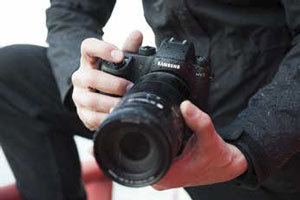articles/Cameras/which-compact-system-camera-page3
You've got to have a system - part 3 of 1 2 3 4 5 6 7
Published 10/04/2015

Samsung NX1
Samsung's compact system range topper was first announced at Photokina back in September 2014, and has recently been joined by the NX500, similar in spec, yet with a more portable form factor. Aimed at hobbyists and semi-professionals, the 28 effective megapixel Samsung NX1 in many ways resembles the camera that all previous NX products were building towards. In terms of overall performance and speed of capture the NX1 far exceeds being merely up to scratch, offering up to 15 frames per second continuous capture for up to 70 sequential frames, plus a hybrid AF system that twins a massive 205 phase detection AF points with 209 contrast AF points. Not only swiftness, but spot-on accuracy is the result.
Incorporated once more is an APS-C format sensor that has been the making of the range and delivering, for us, imagery that, up to A3 in size, could pass professional muster. Whether there is a market for a camera with Samsung's name on it costing £1,300 body-only (therefore comparable to a semi-pro Canon or Nikon) and a system currently with 16 compatible lenses is a question to ponder, however, while time will tell whether its audience transpires to be more videographer or stills shooter, as its other main talking point is 4K video capture. In this respect it is a direct rival of Panasonic's similarly enabled GH4. The other possible contenders in the price bracket of both are the Sony A7 series trio, Olympus OM-D E-M1/E-M5 Mark II and Fuji X-T1.
While the design is a little modernistic compared to the XT-1 or any 35mm DSLR body one could mention, first impressions of this Samsung impress. We got to play with the NX1 equipped with a large, image-stabilised 50-150mm telephoto zoom, further indicating, along with the dust and weather-resistant construction, that this is a possible semi-pro workhorse. It appears to buck the trend that the whole CSC pitch was built on; namely smaller bodies, but near DSLR image quality - the camera and lens feeling reassuringly weighty in tandem. Bulky when compared to what else is out there, it surely encroaches on DSLR territory for heft. But in fact, when detached from its lens, the body feels relatively lightweight given the heavyweight specification offer, with official figures suggesting a body-only 550g, making it lighter than the average DSLR.

As one would expect, equip the NX1 with the supplied 50-150mm which features the distinct advantage of a constant f2.8 aperture throughout its focal range and you have the very definition of jack-of-all-trades, particularly for candid portraiture in natural light, when an attractively defocused background that directs your viewer's attention straight to the subject is just the ticket. That bright/fast aperture also naturally lets in more light, so even at maximum zoom we were getting shake-free results. An alternative kit option is to bundle the NX1 body with a 16-50mm lens for starters, with extras including the ability to add a vertical battery grip to make for more comfortable shooting in portrait fashion, whilst also having the effect of bulking the camera out further. It's evident from such accessories that the NX1 is no mere testing of the water in terms of how it might attract higher-end users to the brand; it is clearly serious about its proposition.
Taken as a package, camera specification also indicates this is no mere toy. As well as that high-resolution APS-C chip, we also get a tilting AMOLED display (90° upwards, 45° downwards) delivering more life-like visuals with deeper blacks and better contrast to our eyes, plus useful eye-level electronic viewfinder. Both of these framing options provide class-leading high resolutions.
Even with a relatively large lens attached, the equally chunky standard grip on the NX1 stops things from feeling too front-heavy, handling wise, though two-handed support is very much needed when raising the camera up to eye or chest level to compose via EVF or AMOLED respectively. On the camera back we also get buttons ranged to the right and above the articulating screen, as well as a semi-pro DSLR-like status display window atop the camera for keeping track of basic functions.
A 28-megapixel effective resolution from a 30megapixel APS-C sensor is numerically something that we would more usually find married to a physically larger 35mm sensor. This begs the question as to whether all those pixels crammed onto a space that, on competitors' models, is normally reserved for 18 or 20 megapixels, is going to result in more visible grain/image noise? As part of our time playing with the NX1, we took hand-held shots with body plus 50-150mm lens in shadowy, tungsten-lit corridors. Whilst we couldn't avoid some shadows despite the camera having chosen a high ISO1600 sensitivity setting left to its own devices, we were able to drag plenty of detail out of the dim with minimal post-processing. In this respect results were on a par with any 'pro' camera for us.
Please Note:
There is more than one page for this Article.
You are currently on page 3
- You've got to have a system page 1
- You've got to have a system page 2
- You've got to have a system page 3
- You've got to have a system page 4
- You've got to have a system page 5
- You've got to have a system page 6
- You've got to have a system page 7
1st Published 10/04/2015
last update 09/12/2022 15:00:23
More Cameras Articles
There are 0 days to get ready for The Society of Photographers Convention and Trade Show at The Novotel London West, Hammersmith ...
which starts on Wednesday 15th January 2025





